Abstract
The boom in cloud computing and social networking has led to a large number of online users in the networks. It is necessary to use appropriate privacy protection mechanisms to prevent personal privacy leakage. In general, image privacy protection techniques proceed with the whole image. However, the image may contain multiple users’ information, and different people’s data may require different privacy protection. In addition, cloud servers are semi-trusted instead of trusted service providers due to unknown security vulnerabilities and the possibility of grabbing sensitive data from the cloud server. In order to provide image protection with different privacy-preserved access rights and to prevent the cloud server from retrieving sensitive information from the image, we propose a privacy-preserved scheme that supports different privacy-preserved access rights in a single image based on the difficulty of solving the factorization problem and the discrete logarithm problem. The cloud server performed the image management method without knowing the privacy information contained in the protected images. By working out the proposed scheme in detail, we experimentally validate the scheme and discuss various options of access rights in practice.
1. Introduction
With the emergence of digital technology, the world is continuously evolving and rapidly changing. Today, Internet communication has bridged the gap between people. Communication over the Internet ensures an instant connection between people on different sides of the world. Therefore, many cloud service companies offer a cloud-based platform, application, or storage services that allow people to share photos, videos, messages, locations, etc. Among these services, photo sharing and tagging friends in pictures have always been the most popular features of social networks. People like to share or post photos of themselves, family, friends, their life or special activities on their social networks. The photo sharing market is growing at a good clip, and hence we have recently seen an explosion of services that specifically revolve around sharing photos.
Visual cryptography [1,2,3,4,5,6] and information hiding [7,8,9,10,11,12,13,14,15] are proposed for image privacy protection. Social networks also provide some management to let image owners control photo permissions. Even though the account access permission limits only followers or who in the same group can see those photos, the photos could also be leaked by careless transmissions. We note that private information may become publicly available through illegal sources. It may threaten portrait rights and the personal privacy of people who also appeared in the same photo. The traditional mechanisms implement privacy protection only on the whole photo but not special regions and cannot set different privacy permission in one image. We should consider the different needs of protected privacy in different cases. Consequently, we need to develop a new mechanism to do privacy protection separately in a single photo on cloud-based services.
Nowadays, cloud computing is gaining popularity and confidence. Cloud computing has become a convenient and efficient way for companies to store, manage, and access data through the Internet instead of keeping the data on a local drive. Apart from being cost-effective, cloud computing provides elasticity and agility. Corporate cloud computing grows rapidly by more than 35% a year and reached $55.5 billion in Q4 of 2020 [16]. However, as the popularity of cloud computing grows, so will the potential security risks. We cannot completely trust cloud service providers (CSP) due to the fact that the success of accessing cloud services relies on network and authentication. Crashed network and unauthorized access disrupt the cloud-based services. Although CSPs are regulated by stringent regulations, assuming that the data owner and CSPs are in the same trusted domain may not be true since the CSPs may access sensitive information without authorization. Lapse in security risk management could lead to physical or financial harm.
Take celebrity photo leaks in 2014 [17], for example. Almost 500 private pictures of various celebrities were posted on the imageboard website, and later disseminated by other people on social networks. These photos were leaked via the online storage provided by Apple’s cloud services suite iCloud for automatically backing up photos from iOS devices [17]. Apple reported that the victims’ account information was cracked using brute-force attack in the Find My iPhone service which allowed hackers to make unlimited tries to guess victims’ passwords. Many celebrities pursued legal actions and claimed the leak to be a massive invasion of their privacy. It not only violated users’ privacy rights but damaged the company’s reputation.
Moreover, there were two serious data leaks caused by misconfigured Amazon Simple Storage Service (Amazon S3) [18]. One was found by Noah Rotem and Ran Locar [19]. The information of 1000 consultants and consulting firms was breached. The other data leak involved UK-based Fresh Film Productions, which exposed the sensitive data of crews, actors and collaborations [20]. Amazon S3 is a public object storage service that provides management features so that you can configure access to your data to meet your specific business requirements. However, the two leaks indicated that the owners did not define clearly and make the proper settings.
CSP may also have uncovered flaws. In 2020, an authentication problem on Google cloud platform (GCP) shell was found. It could make hackers gain root access to reconfigure any containers [21]. In 2021, Microsoft warned thousands of cloud computing customers that their Microsoft Azure Cosmos DB may have been exposed to intruders [22]. The research team Wiz found that the customers’ primary keys were long-lived and allowed full permission access to customer data [23]. As a result of these reports, we cannot rely on CSP completely.
CSP is semi-reliable; as a result, it is a challenge to accomplish a different permission of privacy protection in a single image. Almuflih et al. [24] proposed a key exchange method by using identity-based encryption in a multipath TCP environment. They also presented the feature-map-based detection for adversarial attacks [25]. Sultana [26] presented a privacy-preserved face image recognition system on MSB encrypted face images. Kumari et al. [27] proposed a secure biometrics-based multi-cloud-server authentication scheme. It used cloud storage and computing power while it did not let the cloud server know the content. They used an elliptic curve cryptosystem (ECC) to build keys among users, registration authorities and cloud servers, and proposed a biometric-based authentication system to make authentication much stricter. Registration authorities authenticate not only users but the cloud servers to make the whole process more secure.
In this paper, we present a privacy-preserved method that supports different access rights in a single image for privacy protection based on the difficulty of solving factoring problems and discrete logarithm problems. We use an access policy to decide who can decrypt the cipher blocks of the image to satisfy every privacy requirement in the original image. The privacy-preserved images with the access policy and authentication information are uploaded to the cloud server. When exploring the image, users follow the authentication information to confirm the blocks that are accessible in their permission to get a decryption key of the blocks to obtain the original image. With the designed strategy, the image management is executed by cloud servers such that cloud servers are not aware of the private information contained in the protected image.
To make this paper self-contained, in Section 2 we introduce the basic concepts of RSA public-key cryptography [28] and ElGamal public-key cryptography [29]. Section 3 explains the proposed scheme consisting of image protection method and image management method. Experimental results and their security analysis appear in Section 4. We also demonstrate how to perform different access rights in a single image for privacy protection. Finally, the paper is concluded in Section 5.
2. Related Works
We designed a privacy-preserved scheme which sets different permissions in a single image with the difficulty of solving the factoring problem and the difficulty of solving the discrete logarithm problem. Hence, we now review some elementary concepts and results from cryptography including RSA public-key cryptography [28] and ElGamal public-key cryptography [29] that are relevant for our paper.
2.1. RSA Public-Key Cryptography
RSA public-key cryptography was proposed by Rivest, Shamir, and Adleman [28] in 1978, and it is the first asymmetric cryptography algorithm in the world. Asymmetric cryptography means that RSA works on two different keys: public key and private key. Data can be encrypted via the public key but can only be decrypted by someone who knows the private key. RSA can be used for encryption and digital signatures. The security of RSA relies on the difficulty of solving the factoring problem, which is an open question about factoring the product of two large prime numbers. The applications of RSA are described as follows.
2.1.1. Key Generation
We assume that the user U1 generates a public key and a private key. The keys for the RSA algorithm are generated as follows.
- Step 1.
- U1 randomly chooses two large prime numbers p1 and q1 and computes n1 = p1 × q1;
- Step 2.
- U1 chooses an integer e1 as a public key such that gcd(e1, φ(n1)) = 1 and φ(n1) = (p1 − 1) × (q1 − 1);
- Step 3.
- U1 computes the private key d1 such that d1 satisfies d1 × e1 ≡ 1 (mod φ(n1));
- Step 4.
- U1 publishes the public key (e1, n1) and keeps the private key d1 secret.
The difficulty of solving factoring problem can be defined as follows. When n1 is the product of two large prime numbers p1 and q1 only n1 is known, it is hard to factor n1 to find p1 and q1.
2.1.2. Encryption and Decryption
Assume that the user U2 wants to send a message m to the user U1. U2 uses U1’s public key (e1, n1) to encrypt m to generate the ciphertext , and sends it to U1. When receiving C, U1 can use U1’s private key d1 to recover the original message by computing .
2.1.3. Digital Signature
In order to verify the origin of messages, RSA can also be used for digital signatures. Assume that the user U1 wants to send a signed message S to the user U2. U1 uses U1’s private key d1 to sign the message m and generates a digital signature . When U2 receives the signed message S and m, U2 can use U1’s public key (e1, n1) to authenticate whether S is generated by U1 or not. U2 computes and compares m with m′. If m and m′ are the same, U2 knows that S is the digital signature of m signed by U1 and trusts that the message has not been tampered with since being sent.
2.2. ElGamal Public-Key Cryptography
ElGamal public-key cryptography is an asymmetric encryption algorithm, which was proposed by ElGamal [29] in 1985. Different from RSA, ElGamal encryption is probabilistic, meaning that one plaintext can be encrypted to many possible different ciphertexts. The security of ElGamal encryption depends upon the difficulty of solving the discrete logarithm problem. The applications of ElGamal encryption are described as follows.
2.2.1. Key Generation
System initially chooses two global parameters p and g, where p is a large prime number and g is the primitive root of p. The user U1 generates a public key and a private key as follows.
- Step 1.
- U1 arbitrarily chooses an integer x1 as a private key;
- Step 2.
- U1 computes the public key ;
- Step 3.
- U1 publishes the public key y1 and keeps the private key x1 secret.
The difficulty of solving the discrete logarithm problem can be defined as follows. When and only y1, p and g are known, it is hard to retrieve x1.
2.2.2. Encryption and Decryption
Assume that the user U2 wants to encrypt a message m to the user U1. U2 chooses a random number r and computes and . U2 sends the ciphertext (b, c) to U1. When receiving (b, c), U1 can use U1’s private key x1 to recover the original message by computing .
2.2.3. Digital Signature
Assume that the user U1 wants to send a signed message to the user U2. A message m is signed by U1 as follows.
- Step 1.
- U1 chooses a random number k such that gcd(k, p − 1) = 1;
- Step 2.
- U1 computes r = gk mod p;
- Step 3.
- U1 finds s satisfying m= (x1r + ks) mod (p − 1);
- Step 4.
- U1 attaches the signature (r, s) to the message.
When U2 receives the signed message (r, s) and m, U2 can use U1’s public key y1 to authenticate the signed message. The signature is valid if and only if gm ≡ y1rrs (mod p).
3. Proposed Scheme
We propose a privacy-preserved scheme that supports different privacy-preserved access rights in a single image based on the difficulty of solving the factorization problem and the discrete logarithm problem. As shown in Figure 1, the image manager can formulate the access policy for specific users in the initialization phase. According to the access policy, specific users can read the original part of authorized blocks in a single image. To prevent private content from being exposed to unauthorized access, the image manager first encrypts the original image in the image protection phase before sending it to the cloud server. The protected images with the access policy will be uploaded to the cloud server. When a user performs image retrieval, the cloud server will provide the user with corresponding authorized images and authentication information according to the access policy. In the image management method, the authorized user can compute the decrypted keys to recover the original content of image blocks. The proposed schemes consisting of an image protection method and an image management method are described as follows.
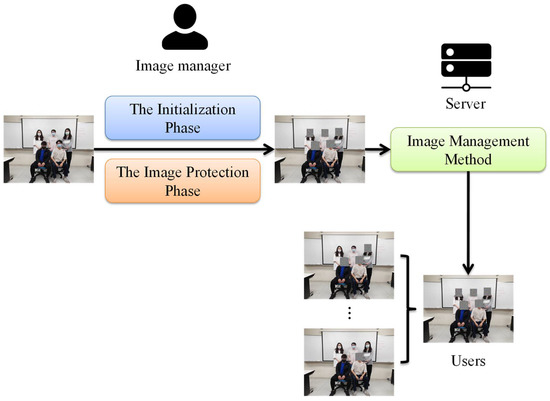
Figure 1.
A framework for supporting different privacy-preserved access rights in a single image.
3.1. Image Protection Method
The image protection method supporting different access rights in a single image for privacy protection is mainly composed of the initialization phase and image protection phase. In the initialization phase, the image manager can configure system parameters and generate keys for every user according to the access policy. In the image protection phase, the image in need of protection is set access rights on blocks to generate the corresponding encrypted image and authentication information. The initialization phase and the image protection phase are presented in the following.
3.1.1. The Initialization Phase
Based on the users’ intention, the image manager institutes the access policy T which comprises α disjoint authorized classes Cj for j = 1, 2, …, α. Each user Ui should belong to a single authorized class Cj, and each authorized class may contain one or several users. The access policy defines Cw ≤ Cr if Cr can access the data of Cw.
First, the image manager chooses two prime numbers p and q and g which is the primitive root modulo n, where n = p × q. Then, the image manager executes Key Generation Algorithm (Algorithm 1). After Cj generates a public key ej, an encrypted key SKj, a derivative key DKj and partial authorized information PTj, the image manager sends PTj= {Cr |Cr ≤ Cj}, DKj, and {er |Cr ≤ Cj and Cr ∈ {C1, C2,…, Cα}} to user Ui ∈ Cj through a secure channel. The image manager keeps SKj secret and sends T and ej to the cloud server. The initialization phase is given in Key Generation Algorithm (Algorithm 1).
| Algorithm 1 Key Generation Algorithm. |
| Input: T |
| Output: ej, SKj, DKj, and PTj for j = 1, 2, …, α |
|
3.1.2. The Image Protection Phase
In order to protect data privacy, the privacy-preserved image should be processed before sending to the cloud server. The image manager executes Image Protection Algorithm (Algorithm 2) to generate an encrypted image EI, image map IM, authentication information AI, and the number of authorized classes δ. Then, EI, IM, AI and δ are uploaded to the cloud server. The flowchart of the Image Protection Algorithm (Algorithm 2) is shown in Figure 2.
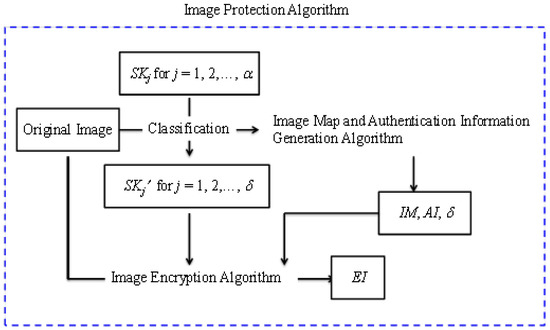
Figure 2.
Flowchart of Image Protection Algorithm (Algorithm 2).
Image Protection Algorithm (Algorithm 2) consists of Image Map and Authentication Information Generation Algorithm (Algorithm 3), Coding Algorithm (Algorithm 4), and Image Encryption Algorithm Algorithm (Algorithm 5). First of all, the image manager defines the mapping between pixels and authorized classes. Image Map and Authentication Information Generation Algorithm (Algorithm 3) and Coding Algorithm (Algorithm 4) are then performed to compute the number of total authorized classes δ to generate the image map IM and the authentication information AI = {(C1′, Code1), (C2′, Code2), …, (Cδ′, Codeδ)}. The image map IM, authentication information AI, and the number of authorized classes δ are used to execute Image Encryption Algorithm (Algorithm 5) to obtain the encrypted image EI. Note that simple exclusive-or operation or symmetric encryption can be used for encryption in Image Encryption Algorithm (Algorithm 5). Using symmetric encryption for encryption is better due to the high-level security, however the fixed-length groups of bits are required in block cipher algorithms, such as AES and 3DES.
| Algorithm 2 Image Protection Algorithm. |
| Input: An original image and SKj for j = 1, 2, …, α |
| Output: The encrypted image EI, image map IM, authentication information AI, the number δ of the involved access rights |
|
| Algorithm 3 Image Map and Authentication Information Generation Algorithm. |
| Input: A protection-pixel-defined image and the corresponding classes |
| Output: Image map IM, authentication information AI, and the number δ of the involved access rights |
|
| Algorithm 4 Coding Algorithm. |
| Input: φ and δ involved classes Cj′ for j = 1, 2, ..., δ |
| Output: (Cj′, Codej) for j = 1, 2, ..., δ |
| For j = 1, 2, ..., δ, generate the code Codej of φ bits for Cj′ by setting Codej = j2, where j2 denotes the binary representation of j. |
| Algorithm 5 Image Encryption Algorithm. |
| Input: The original image, IM, AI = {(C1′, Code1), (C2′, Code2), …, (Cδ′, Codeδ)}, and SKj′ of Cj′ for j = 1, 2, ..., δ |
| Output: The encrypted image EI |
|
3.2. Image Management Method
The cloud server can provide privacy-preserved image retrieval without knowing the data privacy. The user Ui (Ui ∈ Cw) sends a request to the cloud server to ask to see an encrypted image EI. The cloud server can determine whether the user has rights to access this image or not according to the access policy T. The user Ui has the access rights if Cj′ < Cw in T and then the cloud server will send EI, IM, AI and δ to Ui. Since the image manager sends PTj= {Cr |Cr ≤ Cj}, DKj, and {er |Cr ≤ Cj and Cr ∈ {C1, C2,…, Cα}} to user Ui ∈ Cj through a secure channel in the initialization phase of the image protection method, Ui can execute the following steps to recover the original content of accessible blocks.
- Step 1.
- For each accessible Cj′ in EI, Ui computes SKj′ = according to PTw;
- Step 2.
- For each accessible Cj′ in EI, Ui uses Codej and IM to find the region of the authorized pixels in EI;
- Step 3.
- For the region of the authorized pixels of Cj′, Ui uses SKj′ to decrypt the encrypted pixels to recover the original content.
4. Experimental Results
In this section, we conduct several experiments to evaluate the performance of our proposed scheme. The proposed scheme is implemented using python 3.10.4 and an open source pycryptodome 3.14.1 library on a PC with Intel Core i7-8750H 2.20 GHz CPU, 8 GB RAM, and 64-bits Windows 11 system. To make the process more secure and effective, an AES symmetric cryptosystem is used to encrypt the privacy-protected pixels with secret and derivative keys generated by RSA [28] and ElGamal [29]. The encrypted blocks can be decrypted by the derivative key and users’ public keys according to the access policy. To demonstrate the feasibility and effectiveness of our scheme for privacy protection, portrait images are used in the analysis.
4.1. Initialization
In the initialization phase, we take two large 128-bit prime numbers p and q validated by Miller Rabin Primality test [30] and then multiply them together to create a modulus n. As shown in Key Generation Algorithm (Algorithm 1), we use RSA cryptosystem to generate Cj’s public key ej and private key dj, and combine ElGamal cryptosystem to obtain secret key SKj and derivative key DKj. Let us assume that we compute n = 3602891806881971 and g = 29881307. The parameters of Cj used in the initialization phase are listed in Table 1.

Table 1.
The parameters of Cj.
4.2. Evaluation
We predetermine the privacy blocks that need to be protected to create the access policy. Let us assume that each user is in one class and each class has one access right in the access policy. According to the image map IM and authentication information AI, RGB layers of face region Plaintextj are encrypted by AES with SKj. Figure 3 shows the encrypted result of the test portrait image. We can see from Figure 3 that the distribution of encrypted pixel values is relatively uniform and it has no relationship with the original image.
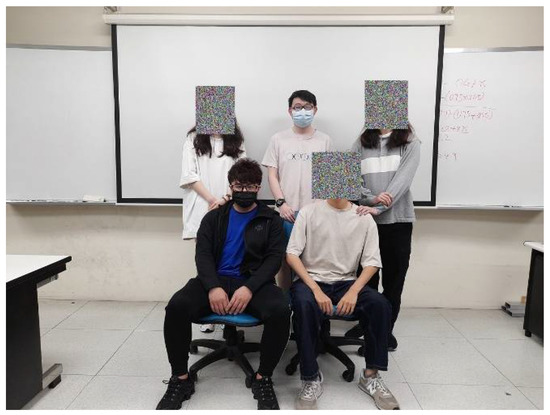
Figure 3.
The encrypted result.
The user sends a request to the cloud server to ask for seeing the encrypted image. The cloud server can determine if the user has rights to access this image or not according to access policy T. When receiving the derivative key DKj and corresponding public keys, the user can compute SKj′ to decrypt the encrypted blocks. Taking DK2 and e2 as an example, computing the SK1′ of C2 as mod n = 20389658814410524590087 mod 3602891806881971 = 1616955632228291 to decrypt the block of C1. The decrypted results for different accessible classes C1, C2, and C3 are shown in Figure 4. Note that the users cannot decrypt other privacy-protected blocks while they do not have access rights on them in access policy.
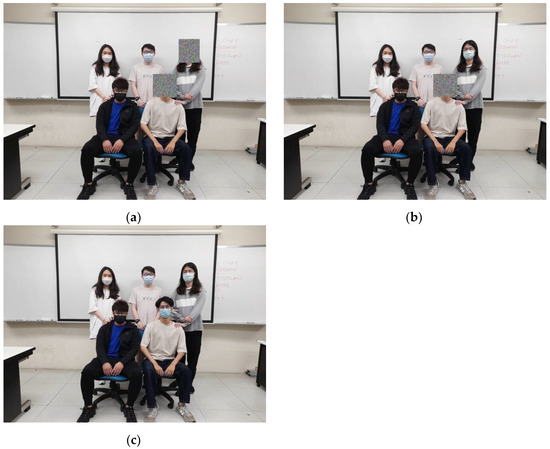
Figure 4.
Images of accessible classes C1, C2, and C3 decrypted by SK1′, SK2′, and SK3′, respectively. (a) class C1; (b) class C2; (c) class C3.
For adapting to different access policies, we try to encrypt three blocks for single class, and one block for different users in the same class, which is shown in Figure 5. The corresponding decryptions of multi-blocks are given in Figure 6. We can see that there is no difference between different users and a single user since encryption and decryption are dependent on authorized classes. Furthermore, we also notice that the quantity of blocks needed for a class does not lead to any encryption and decryption failure.
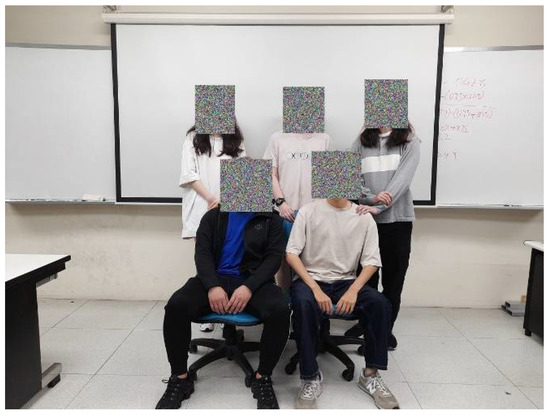
Figure 5.
The encrypted result of multi-blocks.
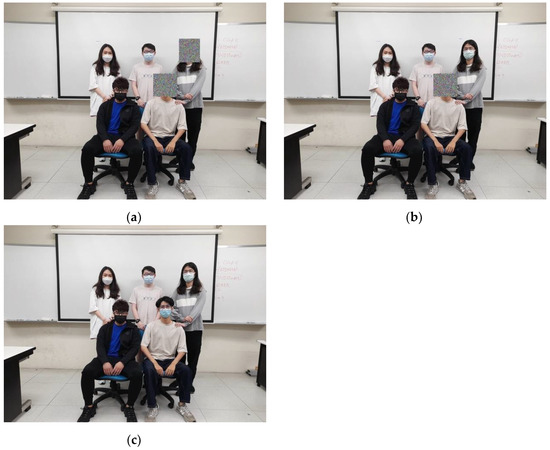
Figure 6.
Images of accessible classes C1, C2, and C3 decrypted by SK1′, SK2′, and SK3′, respectively. (a) class C1; (b) class C2; (c) class C3.
The above examples are considered as the hierarchical access control. We can see in Figure 7a that the class C3 can access every class since it has a very high level of permissions. The class C2 can access the class C1, whereas it cannot access the class C3. As a result, the hierarchical access control may have some restrictions on data access. To make the data access more flexible, the proposed method can provide a flexible access control as shown in Figure 7b. The class C2 and class C3 can access each other; however, only the class C2 can access the class C1. Figure 8 shows the result of the flexible access control. The parameters of Cj used for Figure 7b in the initialization phase are listed in Table 2. For the class C3, it can compute SK2′ of C3 as mod n = 282279047671911818714097 mod 3602891806881971 = 2547499887988133 to decrypt the block of C2. However, it cannot access the class C1 since it cannot get SK1′ by mod n = 2822790476719118(18714097×33389011) mod 3602891806881971 = 29881307 ≠ 2294561867680533.
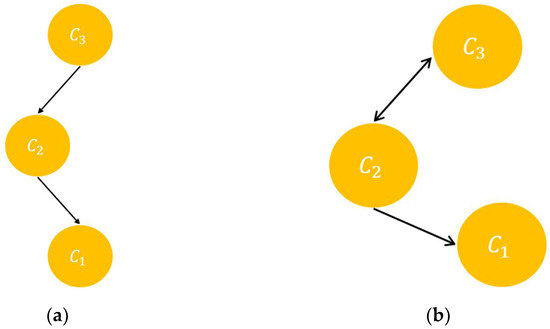
Figure 7.
Access policies. (a) hierarchical classes; (b) flexible classes.
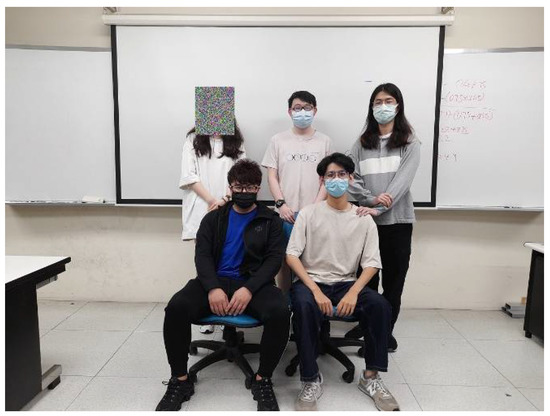
Figure 8.
The result of Figure 7b.

Table 2.
The parameters of Cj for Figure 7b.
Therefore, the proposed method can support flexible access control in practice. The k out of n visual cryptography [1,2,3,4,5,6] can also be extended into a secret sharing scheme. Given a secret image, it will generate n transparencies so that the secret image is revealed if any k or more of them are stacked together but totally concealed if fewer than k transparencies are stacked together. It allows a secret image to be encrypted in such a way that the decrypted information appears as a visual image for human senses. To achieve this end, there is an expansion of space requirement in visual cryptography. The decrypted secret image is an enlarged visual image rather than a real secret image. Moreover, it can be used as a (k, n) threshold scheme, whereas it cannot be designed for a flexible access control for specific users.
We note that the image map IM must be communicated to the users along with the encrypted image for image decryption. The size of the image map depends on the number of authorized classes δ. For each pixel, we use log2(1 + δ) bits to represent its corresponding authorized class. Figure 9 gives an image map example of three authorized classes. In Figure 9, three 10 × 10-pixel blocks B1, B2, and B3 and their corresponding IM data are shown. For each pixel, “00” denotes the non-encryption pixel, “01” represents the class C1, “10” represents the class C2, and “11” represents the class C3. As a result, the original color image is 24 bits per pixel (bpp) and its corresponding image map for three authorized classes is 2 bpp. We can see in Figure 9 that the runs of data that mean the same value occur in consecutive elements and can be used to further reduce the size by using lossless data compression algorithms, such as run-length encoding and modified Huffman coding. Thus, the overhead information that needs to be communicated to the users is small.
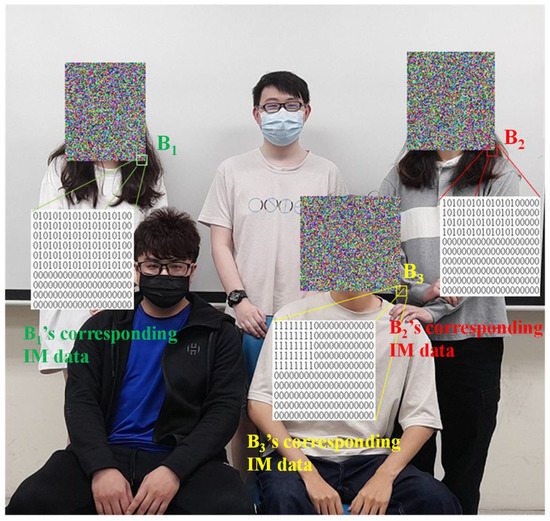
Figure 9.
The image map for three authorized classes.
4.3. Security Analysis
For the purpose of promising safe privacy protection, RSA and ElGamal whose security rely on the difficulty of solving factoring problems and discrete logarithm problems are used in our key generation as described in Key Generation Algorithm (Algorithm 1). To see how the sensitive keys cannot be disclosed from the image protection algorithm, we simulate some scenarios where an adversary who has the advantage of calculation attempts to illegally access the private content.
4.3.1. Scenario 1
Let us assume that an adversary who has corresponding public keys {e′r | C′r ≤ C′j and C′r ∈ {C′1, C′2, …, C′a}} attempts to get {d*r | C′r ≤ C′j and C′r ∈ {C′1, C′2, …, C′a}} to generate a temporary secret key SK*j for decrypting the encrypted image. The adversary will face the open problem about factoring the product of two large prime numbers in order to solve φ(n). Clearly, it is too hard to calculate appropriate d*r. Consequently, the adversary cannot generate the secret key to decrypt the encrypted image even though he has corresponding public keys.
4.3.2. Scenario 2
Suppose that an adversary who has SK*j wants to get other class’s secret keys SK*j+1. The adversary has to guess d*j+1 to obtain SK*j+1. Although he has always known n, g, and SK*j, it is indeed a very big challenge for him to calculate d*j+1 to get other class’s secret key due to the difficulty of solving the discrete logarithm problem.
4.4. Time Analysis
Encrypting the 128-bit data with AES encryption would take 68.45 nanoseconds (ns). Indeed, the AES encryption and decryption are pretty fast. Thus, the most time consuming part of the proposed scheme is calculating the decryption key. To see how long the decryption key calculation takes, let us take five authorized classes. Figure 10 shows an example of how fast the decryption key calculation with five authorized classes runs. We measured the average time taken to perform the decryption key calculation for 1000 times. We can see that it takes only 2.551 microseconds (μs) for C1, and 112.997 μs for C5 since C1 computes one decryption key and C5 computes five decryption keys. Longer calculation time could be taken by further increasing the number of authorized classes. Figure 10 also gives the average time of calculating one decryption key for each authorized class. We note that it would take approximately 5 μs for each additional decryption key calculation. Consequently, the proposed encryption and decryption are more computationally efficient, making the proposed scheme suitable for practical applications.
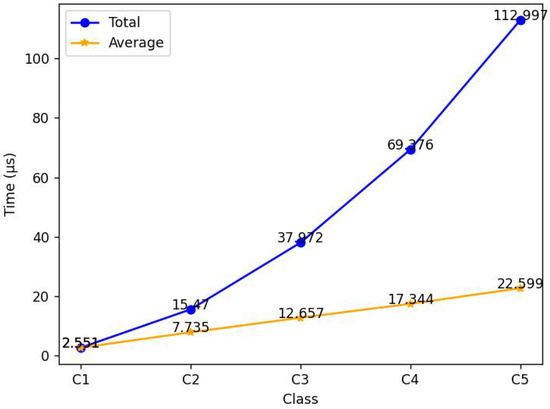
Figure 10.
The average time for calculating the decryption key.
5. Conclusions
In this paper, we proposed a privacy protection scheme that supports different access rights in a single image based on the difficulty of solving factoring problems and discrete logarithm problems. The image manager can institute a different access policy in a single image for specific users. The access policy specifies who has access rights to read the original content of authorized regions. In the image protection method, the image in need of protection is set access rights on blocks to generate the corresponding encrypted image and authentication information. According to the access policy, we used different public keys and private keys built on RSA [28] to generate secret keys and derivative keys followed by ElGamal [29] to encrypt or decrypt the image blocks with AES. Moreover, the AES encryption and decryption are fast.
The encrypted images with the access policy will be uploaded to the cloud server. In the image management method, according to the access policy, the cloud server can determine whether the user has rights to access this image or not, without knowing the privacy information of images. The authorized users can read the original content of encrypted regions according to their access rights. The main benefit is that the proposed method allows users to securely share images across CSPs in semi-trusted cloud environments. Additionally, our method provides flexible access control in a single image for specific users making CSPs authenticate the image without accessing the privacy-preserved content. Performance evaluation results show that our method has no significant computation cost for CSPs and users. Security analysis shows that our image protection method based on the difficulty of solving factoring problems and discrete logarithm problems is secure, and our access control method can resist unauthorized access. Therefore, the proposed scheme not only provides image protection with different privacy-preserved access rights but also prevents the cloud server from leaking private information from the image.
Author Contributions
Methodology, Y.-F.C. and W.-L.T.; formal analysis, Y.-F.C., Y.-T.H. and W.-L.T.; writing—original draft preparation, Y.-T.H.; writing—review and editing, Y.-F.C. and W.-L.T. All authors have read and agreed to the published version of the manuscript.
Funding
This research received no external funding.
Institutional Review Board Statement
Not applicable.
Informed Consent Statement
Informed consent was obtained from all subjects involved in the study.
Data Availability Statement
Not applicable.
Acknowledgments
This work was supported in part by the Ministry of Science and Technology under grants MOST 110-2221-E-025-012-, MOST 111-2221-E-025-007-, and MOST 110-2221-E-025-014-MY2.
Conflicts of Interest
The authors declare no conflict of interest.
References
- Naor, M.; Shamir, A. Visual cryptography. In Proceedings of the Workshop on the Theory and Application of Cryptographic Techniques, Perugia, Italy, 9–12 May 1994; pp. 1–12. [Google Scholar]
- Li, P.; Ma, J.; Yin, L.; Ma, Q. A construction method of (2, 3) visual cryptography scheme. IEEE Access 2020, 8, 32840–32849. [Google Scholar] [CrossRef]
- Chiu, P.L.; Lee, K.H. Threshold visual cryptography schemes with tagged shares. IEEE Access 2020, 8, 111330–111346. [Google Scholar] [CrossRef]
- Yang, C.N.; Yang, Y.Y. On the analysis and design of visual cryptography with error correcting capability. IEEE Trans. Circuits Syst. Video Technol. 2021, 31, 2465–2479. [Google Scholar] [CrossRef]
- Pan, J.S.; Liu, T.; Yang, H.M.; Yan, B.; Chu, S.C.; Zhu, T. Visual cryptography scheme for secret color images with color QR codes. J. Vis. Commun. Image Represent. 2022, 82, 103405. [Google Scholar] [CrossRef]
- Li, P.; Yin, L.; Ma, J.; Wang, H. XOR-based visual cryptography scheme with essential shadows. J. Vis. Commun. Image Represent. 2022, 85, 103513. [Google Scholar] [CrossRef]
- Chang, Y.F.; Tai, W.L. A block-based watermarking scheme for image tamper detection and self-recovery. Opto-Electron. Rev. 2013, 21, 182–190. [Google Scholar] [CrossRef]
- Lin, C.C.; Huang, Y.H.; Tai, W.L. A novel hybrid image authentication scheme based on absolute moment block truncation coding. Multimed. Tools Appl. 2017, 76, 463–488. [Google Scholar] [CrossRef]
- Tai, W.L.; Chang, Y.F. Separable reversible data hiding in encrypted signals with public key cryptography. Symmetry 2018, 10, 23. [Google Scholar] [CrossRef]
- Tai, W.L.; Liao, Z.J. Image self-recovery with watermark self-embedding. Signal Process. Image Commun. 2018, 65, 11–25. [Google Scholar]
- Chen, C.C.; Chang, C.C.; Lin, C.C.; Su, G.D. TSIA: A novel image authentication scheme for AMBTC-based compressed images using turtle shell based reference matrix. IEEE Access 2019, 7, 149515–149526. [Google Scholar] [CrossRef]
- Hong, W.; Chen, J.; Chang, P.S.; Wu, J.; Chen, T.S.; Lin, J. A color image authentication scheme with grayscale invariance. IEEE Access 2020, 9, 6522–6535. [Google Scholar] [CrossRef]
- Chen, T.S.; Zhou, X.; Chen, R.C.; Wong, W.; Chen, K.S. A high fidelity authentication scheme for AMBTC compressed image using reference table encoding. Mathematics 2021, 9, 2610. [Google Scholar] [CrossRef]
- Zhang, T.; Weng, S.; Wu, Z.; Lin, J.; Hong, W. Adaptive encoding based lossless data hiding method for VQ compressed images using tabu search. Inf. Sci. 2022, 602, 128–142. [Google Scholar] [CrossRef]
- Wang, Z.; Feng, G.; Zhang, X. Repeatable data hiding: Towards the reusability of digital images. IEEE Trans. Circuits Syst. Video Technol. 2022, 32, 135–146. [Google Scholar] [CrossRef]
- The Cloud Infrastructure Market Hit $129B in 2020. Available online: https://techcrunch.com/2021/02/04/the-cloud-infrastructure-market-hit-129b-in-2020/ (accessed on 23 October 2021).
- This Could Be the iCloud Flaw that Led to Celebrity Photos Being Leaked (Update: Apple is Investigating). Available online: https://thenextweb.com/news/this-could-be-the-apple-icloud-flaw-that-led-to-celebrity-photos-being-leaked (accessed on 23 October 2021).
- Exposed AWS Buckets Again Implicated in Multiple Data Leaks. Available online: https://www.computerweekly.com/news/252476870/Exposed-AWS-buckets-again-implicated-in-multiple-data-leaks (accessed on 23 October 2021).
- Report: 1,000s of UK Consultants and Firms Exposed in Huge Data Leak. Available online: https://www.vpnmentor.com/blog/report-chs-leak/ (accessed on 23 October 2021).
- Exclusive: Production Company Data Breach Exposes Personal Data of Dove ‘Real People’ Ad Participants. Available online: https://www.verdict.co.uk/fresh-film-data-breach-dove/ (accessed on 23 October 2021).
- $100K Paid Out for Google Cloud Shell Root Compromise. Available online: https://threatpost.com/100k-google-cloud-shell-root-compromise/153665/ (accessed on 23 October 2021).
- Exclusive Microsoft Warns Thousands of Cloud Customers of Exposed Databases. Available online: https://www.reuters.com/technology/exclusive-microsoft-warns-thousands-cloud-customers-exposed-databases-emails-2021-08-26/ (accessed on 23 October 2021).
- ChaosDB: How We Hacked Thousands of Azure customers’ Databases. Available online: https://www.wiz.io/blog/chaosdb-how-we-hacked-thousands-of-azure-customers-databases (accessed on 23 October 2021).
- Kumari, S.; Li, X.; Wu, F.; Das, A.K.; Choo, K.R. Design of a provably secure biometrics-based multi-cloud-server authentication scheme. Future Gener. Comput. Syst. 2017, 68, 320–330. [Google Scholar] [CrossRef]
- Almuflih, A.S.; Vyas, D.; Kapdia, V.V.; Qureshi, M.R.N.M.; Qureshi, K.M.R.; Makkawi, E.A. Novel exploit feature-map-based detection of adversarial attacks. Appl. Sci. 2022, 12, 5161. [Google Scholar] [CrossRef]
- Almuflih, A.S.; Popat, K.; Kapdia, V.V.; Qureshi, M.R.N.M.; Almakayeel, N.; Mamlook, R.E.A. Efficient key exchange using identity-based encryption in multipath TCP environment. Appl. Sci. 2022, 12, 7575. [Google Scholar] [CrossRef]
- Sultana, S.F.; Shubhangi, D.C. Privacy preserved image recognition on MSB encrypted images. Int. J. Adv. Res. Comput. Commun. Eng. 2015, 4, 395–398. [Google Scholar]
- Rivest, R.L.; Shamir, A.; Adleman, L.M. A method for obtaining digital signatures and public-key cryptosystems. Commun. ACM 1978, 21, 120–126. [Google Scholar] [CrossRef]
- ElGamal, T. A public-key cryptosystem and a signature scheme based on discrete logarithms. IEEE Trans. Inf. Theory 1985, 31, 469–472. [Google Scholar] [CrossRef]
- Rabin, M.O. Probabilistic algorithm for testing primality. J. Number Theory 1980, 12, 128–138. [Google Scholar] [CrossRef]
Publisher’s Note: MDPI stays neutral with regard to jurisdictional claims in published maps and institutional affiliations. |
© 2022 by the authors. Licensee MDPI, Basel, Switzerland. This article is an open access article distributed under the terms and conditions of the Creative Commons Attribution (CC BY) license (https://creativecommons.org/licenses/by/4.0/).